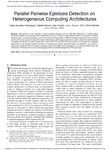Mostrar o rexistro simple do ítem
Parallel Pairwise Epistasis Detection on Heterogeneous Computing Architectures
| dc.contributor.author | González-Domínguez, Jorge | |
| dc.contributor.author | Ramos Garea, Sabela | |
| dc.contributor.author | Touriño, Juan | |
| dc.contributor.author | Schmidt, Bertil | |
| dc.date.accessioned | 2019-02-14T15:07:18Z | |
| dc.date.available | 2019-02-14T15:07:18Z | |
| dc.date.issued | 2016-08 | |
| dc.identifier.citation | J. González-Domínguez, S. Ramos, J. Touriño and B. Schmidt, "Parallel Pairwise Epistasis Detection on Heterogeneous Computing Architectures," in IEEE Transactions on Parallel and Distributed Systems, vol. 27, no. 8, pp. 2329-2340, 1 Aug. 2016. doi: 10.1109/TPDS.2015.2460247 | es_ES |
| dc.identifier.issn | 1045-9219 | |
| dc.identifier.issn | 1558-2183 | |
| dc.identifier.uri | http://hdl.handle.net/2183/21755 | |
| dc.description | This is a post-peer-review, pre-copyedit version of an article published in IEEE Transactions on Parallel and Distributed Systems. The final authenticated version is available online at: http://dx.doi.org/10.1109/TPDS.2015.2460247. | es_ES |
| dc.description.abstract | [Abstract] Development of new methods to detect pairwise epistasis, such as SNP-SNP interactions, in Genome-Wide Association Studies is an important task in bioinformatics as they can help to explain genetic influences on diseases. As these studies are time consuming operations, some tools exploit the characteristics of different hardware accelerators (such as GPUs and Xeon Phi coprocessors) to reduce the runtime. Nevertheless, all these approaches are not able to efficiently exploit the whole computational capacity of modern clusters that contain both GPUs and Xeon Phi coprocessors. In this paper we investigate approaches to map pairwise epistasic detection on heterogeneous clusters using both types of accelerators. The runtimes to analyze the well-known WTCCC dataset consisting of about 500 K SNPs and 5 K samples on one and two NVIDIA K20m are reduced by 27 percent thanks to the use of a hybrid approach with one additional single Xeon Phi coprocessor. | es_ES |
| dc.description.sponsorship | Wellcome Trust; 076113 | es_ES |
| dc.description.sponsorship | Wellcome Trust; 085475 | es_ES |
| dc.description.sponsorship | Ministerio de Ecnomía y Competitividad; TIN2013-42148-P | es_ES |
| dc.language.iso | eng | es_ES |
| dc.publisher | Institute of Electrical and Electronics Engineers | es_ES |
| dc.relation.uri | http://dx.doi.org/10.1109/TPDS.2015.2460247. | es_ES |
| dc.subject | Coprocessors | es_ES |
| dc.subject | Graphics processing units | es_ES |
| dc.subject | Computational modeling | es_ES |
| dc.subject | Computer architecture | es_ES |
| dc.subject | Data models | es_ES |
| dc.subject | Genetics | es_ES |
| dc.subject | Acceleration | es_ES |
| dc.title | Parallel Pairwise Epistasis Detection on Heterogeneous Computing Architectures | es_ES |
| dc.type | info:eu-repo/semantics/article | es_ES |
| dc.rights.access | info:eu-repo/semantics/openAccess | es_ES |
| UDC.journalTitle | IEEE Transactions on Parallel and Distributed Systems | es_ES |
| UDC.volume | 27 | es_ES |
| UDC.issue | 8 | es_ES |
| UDC.startPage | 2329 | es_ES |
| UDC.endPage | 2340 | es_ES |
| dc.identifier.doi | 10.1109/TPDS.2015.2460247 |
Ficheiros no ítem
Este ítem aparece na(s) seguinte(s) colección(s)
-
GI-GAC - Artigos [192]






